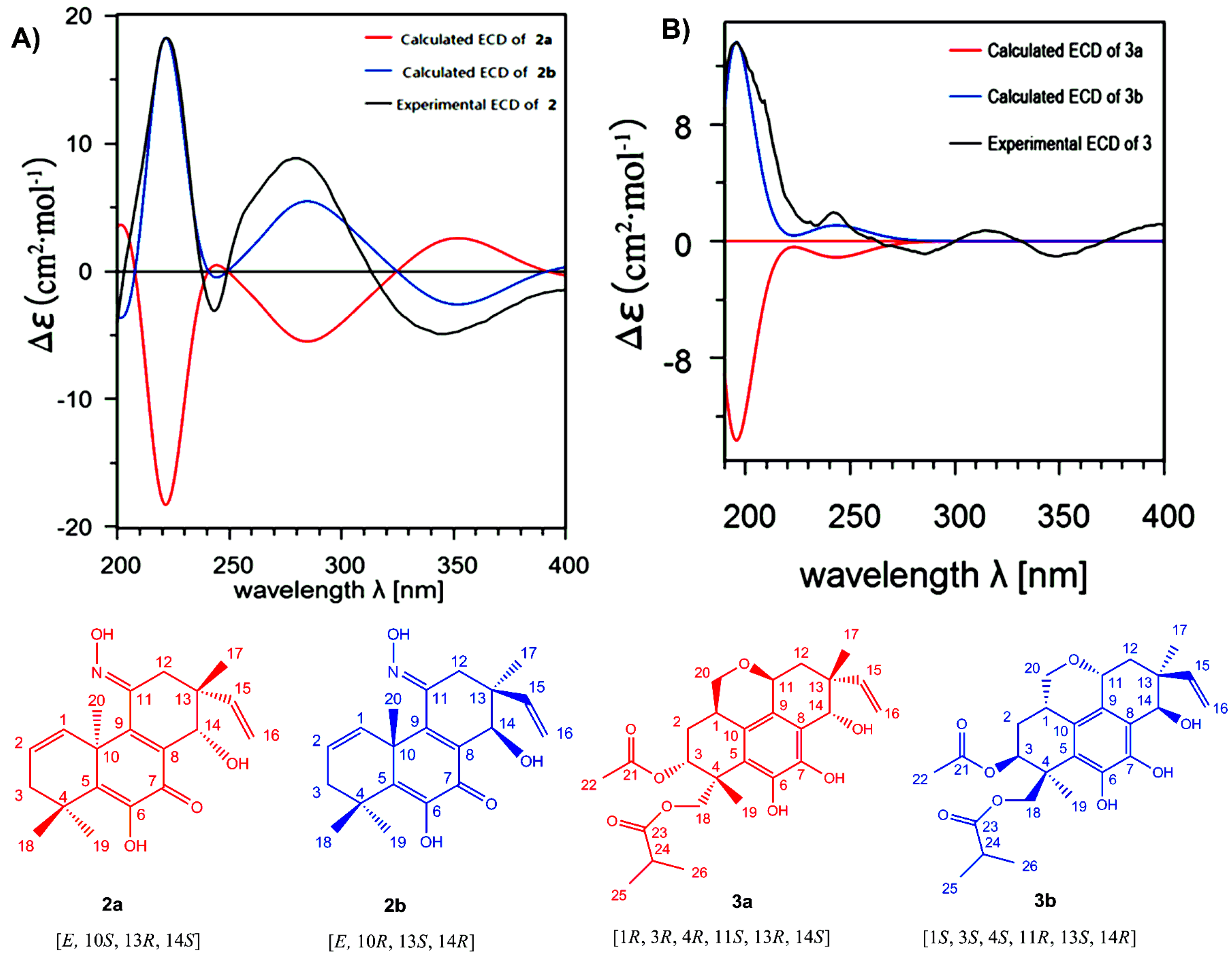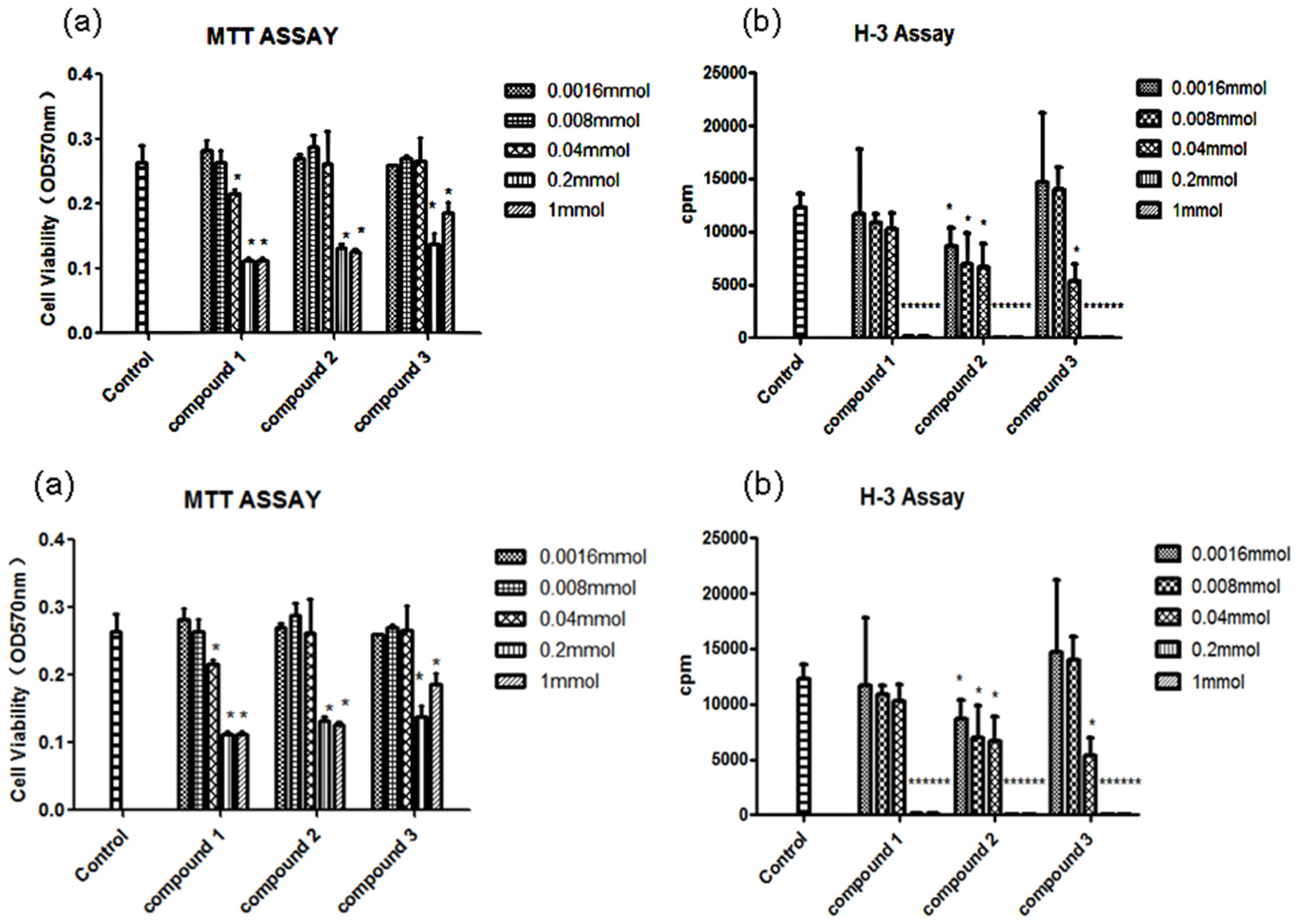Eutypenoids A–C: Novel Pimarane Diterpenoids from the Arctic Fungus Eutypella sp. D-1
Abstract
:1. Introduction
2. Results and Discussion
3. Experimental Section
3.1. General Experimental Procedures
3.2. Fungal Strain
3.3. Culture Condition
3.4. Extraction and Isolation
3.5. Material and Method
3.6. Antiproliferation Assay
4. Conclusions
Supplementary Files
Supplementary File 1Acknowledgments
Author Contributions
Conflicts of Interest
References
- Blunt, J.W.; Copp, B.R.; Keyzers, R.A.; Munro, M.H.G.; Prinsep, M.R. Marine natural products. Nat. Prod. Rep. 2013, 30, 237–323. [Google Scholar] [CrossRef] [PubMed]
- Blunt, J.W.; Copp, B.R.; Keyzers, R.A.; Munro, M.H.G.; Prinsep, M.R. Marine natural products. Nat. Prod. Rep. 2014, 31, 160–258. [Google Scholar] [CrossRef] [PubMed]
- Blunt, J.W.; Copp, B.R.; Keyzers, R.A.; Munro, M.H.G.; Prinsep, M.R. Marine natural products. Nat. Prod. Rep. 2015, 32, 116–211. [Google Scholar] [CrossRef] [PubMed]
- Timling, I.; Walker, D.A.; Nusbaum, C.; Lennon, N.J.; Taylor, D.L. Rich and cold: Diversity, distribution and drivers of fungal communities in patterned-ground ecosystems of the North American Arctic. Mol. Ecol. 2014, 23, 3258–3272. [Google Scholar] [CrossRef] [PubMed]
- Pongcharoen, W.; Rukachaisirikul, V.; Phongpaichit, S.; Rungjindamai, N.; Sakayaroj, J. Pimarane diterpene and cytochalasin derivatives from the endophytic fungus Eutypella scoparia PSU-D44. J. Nat. Prod. 2006, 69, 856–858. [Google Scholar] [CrossRef] [PubMed]
- Ciavatta, M.L.; Lopez-Gresa, M.P.; Gavagnin, M.; Nicoletti, R.; Manzo, E.; Mollo, E.; Guo, Y.W.; Cimino, G. Cytosporin-related compounds from the marine-derived fungus Eutypella scoparia. Tetrahedron 2008, 64, 5365–5369. [Google Scholar] [CrossRef]
- Isaka, M.; Palasarn, S.; Lapanun, S.; Chanthaket, R.; Boonyuen, N.; Lumyong, S. γ-Lactones and ent-eudesmane sesquiterpenes from the endophytic fungus Eutypella sp. BCC 13199. J. Nat. Prod. 2009, 72, 1720–1722. [Google Scholar] [CrossRef] [PubMed]
- Isaka, M.; Palasarn, S.; Prathumpai, W.; Laksancharoen, P. Pimarane diterpene from the endophytic fungus Eutypella sp. BCC 13199. Chem. Pharm. Bull. 2011, 59, 1157–1159. [Google Scholar] [CrossRef] [PubMed]
- Sun, L.; Li, D.L.; Chen, Y.C.; Tao, M.H.; Zhang, W.M.; Dan, F.J. Purification, identification and antitumor activities of secondarymetabolites from marine fungus Eutypella scoparia FS26. Mycosystema 2011, 30, 268–274. [Google Scholar]
- Sun, L.; Li, D.L.; Tao, M.H.; Dan, F.J.; Zhang, W.M. Two new sesquiterpenes from the marine fungus Eutypella scoparia FS26 from the South China Sea. Helv. Chim. Acta 2012, 95, 157–162. [Google Scholar] [CrossRef]
- Sun, L.; Li, D.L.; Tao, M.H.; Chen, Y.C.; Dan, F.J.; Zhang, W.M. Scopararanes C–G: New oxygenated pimarane diterpenes from the marine sediment-derived fungus Eutypella scoparia FS26. Mar. Drugs 2012, 10, 539–550. [Google Scholar] [CrossRef] [PubMed]
- Sun, L.; Li, D.L.; Tao, M.H.; Chen, Y.C.; Zhang, Q.B.; Dan, F.J.; Zhang, W.M. Two new polyketides from a marine sediment-derived fungus Eutypella scoparia FS26. Nat. Prod. Res. 2013, 127, 1298–1304. [Google Scholar] [CrossRef] [PubMed]
- Kongprapan, T.; Rukachaisirikul, V.; Saithong, S.; Phongpaichit, S.; Poonsuwan, W.; Sakayaroj, J. Cytotoxic cytochalasins from the endophytic fungus Eutypella scoparia PSU-H267. Phytochem. Lett. 2015, 13, 171–176. [Google Scholar] [CrossRef]
- Lu, X.L.; Liu, J.T.; Liu, X.Y.; Gao, Y.; Zhang, J.P.; Jiao, B.H.; Zheng, H. Pimarane diterpenes from the Arctic fungus Eutypella sp. D-1. J. Antibiot. 2014, 67, 171–174. [Google Scholar] [CrossRef] [PubMed]
- Liu, J.T.; Hu, B.; Gao, Y.; Zhang, J.P.; Jiao, B.H.; Lu, X.L.; Liu, X.Y. Bioactive tyrosine-derived cytochalasins from Fungus Eutypella sp. D-1. Chem. Biodivers. 2014, 11, 800–806. [Google Scholar] [CrossRef] [PubMed]
- Liu, X.Y.; Chen, X.C.; Qian, F.; Zhu, T.T.; Xu, J.W.; Li, Y.M.; Zhang, L.Q.; Jiao, B.H. Chlorinated phenolic sesquiterpenoids from the Arctic fungus Nectria sp. B-13. Biochem. Syst. Ecol. 2015, 59, 22–25. [Google Scholar] [CrossRef]
- Cho, J.G.; Cha, B.J.; Min Lee, S.; Shrestha, S.; Jeong, R.H.; Sung Lee, D.; Kim, Y.C.; Lee, D.G.; Kang, H.C.; Kim, J.; et al. Diterpenes from the roots of Oryza sativa L. and their inhibition activity on NO production in LPS-stimulated RAW264.7 macrophages. Chem. Biodivers. 2015, 12, 1356–1364. [Google Scholar] [CrossRef] [PubMed]
- Wu, Z.Y.; Zhang, Y.B.; Zhu, K.K.; Luo, C.; Zhang, J.X.; Cheng, C.R.; Feng, R.H.; Yang, W.Z.; Zeng, F.; Wang, Y.; et al. Anti-inflammatory diterpenoids from the root bark of Acanthopanax gracilistylus. J. Nat. Prod. 2014, 77, 2342–2351. [Google Scholar] [CrossRef] [PubMed]
- Feng, Y.H.; Zhu, Y.N.; Liu, J.; Ren, Y.X.; Xu, J.Y.; Yang, Y.F.; Li, X.Y.; Zou, J.P. Differential regulation of resveratrol on lipopolysacchride-stimulated human macrophages with or without IFN-gamma pre-priming. Int. Immunopharmacol. 2004, 4, 713–720. [Google Scholar] [CrossRef] [PubMed]
- Berova, N.; Di Bari, L.; Pescitelli, G. Application of electronic circular dichroism in configurational and conformational analysis of organic compounds. Chem. Soc. Rev. 2007, 36, 914–931. [Google Scholar] [CrossRef] [PubMed]
- Miao, F.P.; Liang, X.R.; Yin, X.L.; Wang, G.; Ji, N.Y. Absolute configurations of unique harziane diterpenes from Trichoderma species. Org. Lett. 2012, 14, 3815–3817. [Google Scholar] [CrossRef] [PubMed]
- Bruhn, T.; Schaumloffel, A.; Hemberger, Y.; Bringmann, G. SpecDis: Quantifying the comparison of calculated and experimental electronic circular dichroism spectra. Chirality 2013, 25, 243–249. [Google Scholar] [CrossRef] [PubMed]






| No. | 1 | 2 | 3 | |||
|---|---|---|---|---|---|---|
| δC a | δH b (J in Hz) | δC c | δH d (J in Hz) | δC a | δH b (J in Hz) | |
| 1 | 67.2, CH2 | 3.71, d (13.1) | 132.2, CH | 6.15, dd (3.3, 9.5) | 28.7, CH | 2.88, m |
| 2.90, t (12.3) | ||||||
| 2 | 27.6, CH2 | 1.97, m | 127.8, CH | 6.02, m | 25.7, CH2 | 2.15, m 1.45, m |
| 1.58, m | ||||||
| 3 | 40.6, CH2 | 1.66, m | 39.6, CH2 | 2.47, d (16.0) | 72.8, CH | 5.20, d (2.7) |
| 2.05, dd (7.7, 16.0) | ||||||
| 4 | 49.8, C | 38.3, C | 41.3, C | |||
| 5 | 138.6, C | 146.6, C | 122.7, C | |||
| 6 | 149.3, C | 143.0, C | 143.3, C | |||
| 7 | 179.0, C | 181.3, C | 142.3, C | |||
| 8 | 129.6, C | 133.6, C | 119.2, C | |||
| 9 | 148.8, C | 153.0, C | 124.7, C | |||
| 10 | 76.9, C | 44.8, C | 126.2, C | |||
| 11 | 124.1, CH | 7.54, d (8.0) | 153.5, C | 66.5, CH | 4.60, dd (6.2, 10.6) | |
| 12 | 135.0, CH | 7.43, d (8.0) | 28.7, CH2 | 2.86, s | 42.6, CH2 | 2.18, m 1.72, m |
| 13 | 136.5, C | 39.7, C | 43.3, C | |||
| 14 | 140.6, C | 69.8, CH | 4.68, s | 76.5, CH | 4.82, s | |
| 15 | 137.1, CH | 7.19, dd (11.5, 18.0) | 142.4, CH | 6.06, dd (18.0, 10.8) | 138.2, CH | 5.92, dd (10.7, 17.7) |
| 16 | 117.0, CH2 | 5.49, d (11.5) | 114.4, CH2 | 5.20, d (18.0) | 119.8, CH2 | 5.36, d (10.7) |
| 5.06, d (18.0) | 5.17, d (10.8) | 5.33, d (17.7) | ||||
| 17 | 21.4, CH3 | 2.37, s | 23.9, CH3 | 1.05, s | 23.5, CH3 | 1.31, s |
| 18 | 20.1, CH3 | 1.47, s | 27.9, CH3 | 1.28, s | 66.3, CH2 | 5.16, d (10.7) |
| 4.31, d (10.7) | ||||||
| 19 | 83.4, CH2 | 4.22, d (8.6) | 27.4, CH3 | 1.53, s | 22.1, CH3 | 1.45, s |
| 4.11, d (8.6) | ||||||
| 20 | 33.1, CH3 | 1.60, s | 27.0, CH3 | 1.62, s | 68.6, CH2 | 4.05, dd (6.5, 8.9) |
| 3.10, dd (8.9, 10.8) | ||||||
| 6-OH/21 | 6.76, s | 170.6, C | ||||
| N-OH/22 | 7.94, s | 21.4, CH3 | 1.97, s | |||
| 23 | 177.1, C | |||||
| 24 | 34.4, CH | 2.53, sep (7.0) | ||||
| 25 | 19.1, CH3 | 1.14, d (7.0) | ||||
| 26 | 19.2, CH3 | 1.12, d (7.0) | ||||
© 2016 by the authors; licensee MDPI, Basel, Switzerland. This article is an open access article distributed under the terms and conditions of the Creative Commons by Attribution (CC-BY) license (http://creativecommons.org/licenses/by/4.0/).
Share and Cite
Zhang, L.-Q.; Chen, X.-C.; Chen, Z.-Q.; Wang, G.-M.; Zhu, S.-G.; Yang, Y.-F.; Chen, K.-X.; Liu, X.-Y.; Li, Y.-M. Eutypenoids A–C: Novel Pimarane Diterpenoids from the Arctic Fungus Eutypella sp. D-1. Mar. Drugs 2016, 14, 44. https://doi.org/10.3390/md14030044
Zhang L-Q, Chen X-C, Chen Z-Q, Wang G-M, Zhu S-G, Yang Y-F, Chen K-X, Liu X-Y, Li Y-M. Eutypenoids A–C: Novel Pimarane Diterpenoids from the Arctic Fungus Eutypella sp. D-1. Marine Drugs. 2016; 14(3):44. https://doi.org/10.3390/md14030044
Chicago/Turabian StyleZhang, Liu-Qiang, Xiao-Chong Chen, Zhao-Qiang Chen, Gui-Min Wang, Shi-Guo Zhu, Yi-Fu Yang, Kai-Xian Chen, Xiao-Yu Liu, and Yi-Ming Li. 2016. "Eutypenoids A–C: Novel Pimarane Diterpenoids from the Arctic Fungus Eutypella sp. D-1" Marine Drugs 14, no. 3: 44. https://doi.org/10.3390/md14030044






